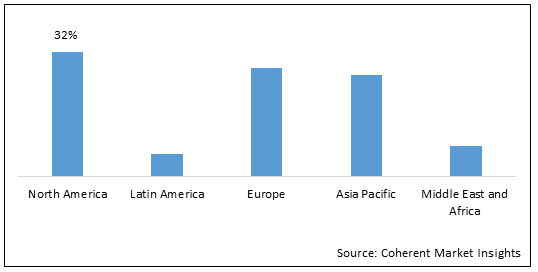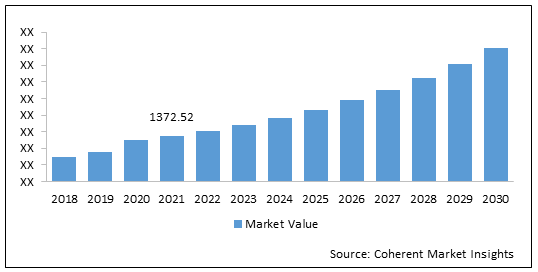Synthetic aperture radar (SAR) is a technique that is used for producing high-resolution images from a resolution-limited radar system. In order to identify physical characteristics, synthetic aperture radar (SAR) bounces a microwave radar signal off the surface of the earth. SAR signals have the ability to penetrate through clouds and the surface underneath them and provide a whole surface view of the earth regardless of the atmospheric conditions. Hence SARs are used for topography, oceanography, and glaciology. They are widely used to monitor phenomena such as deforestation, melting sea ice, droughts, tsunamis, and floods.
Recent Developments:
Increasing Demand for Technology in enhancing Situational Awareness is key factor driving growth of the market. Adoption for advanced technologies in space sector is fueling situational awareness, owing to factors such as government initiatives toward disaster management, increasing need for cyber security, public safety, and smart infrastructure management. For instance, in December 2005, Indian government took initiative towards disaster management by enacting the Disaster Management Act, 2005, which envisioned the creation of the National Disaster Management Authority (NDMA). The objective of this act is to build a safe and disaster resilient country by developing a holistic, proactive, multi-disaster oriented and technology driven strategy through a culture of prevention, mitigation, preparedness, and response.
Restraint:
Synthetic Aperture Radar (SAR) systems are very important for the Earth Observation (EO) business. Synthetic aperture radar satellites system are typically more expensive to develop, and despite distinct advantages, the images are more complex, raising processing costs. Conventional synthetic aperture radars can balance tens of thousands of pounds and as large as a school bus. This are additionally responsible for providing significant capabilities for remote sensing, communication and science, but this costs hundreds of millions of dollars per satellite and may require years to build and launch. Owing to this huge investment required to construct, promotion and operation is expected to restraint the growth of the global synthetic aperture radar market during forecast period.
Global Synthetic Aperture Radar in Space Sector Market:- Impact of Coronavirus (Covid-19) Pandemic
The COVID-19 pandemic forced governments of countries across the globe to declare strict lockdown to curb the rising covid-19 cases. This hampered the business operations for all industries such as manufacturing, technology, trade, and others around the world. Covid-19 influenced the space industry during the pandemic as several projects related to space technology were halted due to financial crises. This affected the global synthetic aperture radar in space sector market witnessing slow growth.
North America held a dominant position in the global synthetic aperture radar in space sector market in 2021.
Statistics:
Europe held a dominant position in the global synthetic aperture radar in space sector market in 2021, followed by Europe and Asia Pacific.
Synthetic Aperture Radar in Space Sector Market Report Coverage
| Report Coverage | Details | ||
|---|---|---|---|
| Base Year: | 2021 | Market Size in 2021: | US$ 1,372.5 Mn |
| Historical Data for: | 2017 to 2020 | Forecast Period: | 2022 to 2030 |
| Forecast Period 2022 to 2030 CAGR: | 9.9 % | 2030 Value Projection: | US$ 4017.6 Mn |
| Geographies covered : |
|
||
| Segments covered: |
|
||
| Companies covered : |
Airbus SE, Lockheed Martin Corporation, Israel Aerospace Industries, Thales Group, Northrop Grumman Corporation, MDA Information Systems, Raytheon Company, Harris Corporation, and BAE Systems. |
||
| Growth Drivers: |
|
||
| Restraints & Challenges: |
|
||
Uncover macros and micros vetted on 75+ parameters: Get instant access to report
Figure 1: Global Synthetic Aperture Radar in Space Sector Market Share (%), By Region, 2021

To learn more about this report, Request sample copy
North America held a dominant position in the synthetic aperture radar in space sector market in 2021 and is expected to maintain its dominance during the forecast period ,owing to the presence of a large number of synthetic aperture radar manufacturers such as Lockheed Martin Corporation (US), Northrop Grumman Corporation (US), and Raytheon Company (US). Furthermore, the armies in U.S and Canada have increased their spending on upgrading the current detection systems which is also contributing to significant growth of the synthetic aperture radar in space sector market.
Asia Pacific is expected to emerge as the fastest-growing region for synthetic aperture radar in the space sector market owing to research and development carried out in satellite and radar imaging technologies. For instance, in April China launched a new civilian remote sensing satellite Gaofen-3 03 into preset orbit. It uses the technology C-band Synthetic Aperture Radar (SAR). This would offer multi-polarization imaging service for both land and sea with the highest resolution.
X-Band segment is expected to drive the global synthetic aperture radar in space sector market during the forecast period
The X band frequency band is widely used for surveillance and mapping activities. The mapping activities include detailed geographical location to support navigation and knowing the geographical terrain. Surveillance has become a top priority in terms of security. The X band frequency provides low interference, low system cost, and requires small antennas at installation. Hence X band frequency is widely used and is expected to drive the global synthetic aperture radar in space sector market in the forecast period.
Figure 2: Global Synthetic Aperture Radar in Space Sector Market Value (US$ Mn) Analysis and Forecast, 2017 - 2030

To learn more about this report, Request sample copy
Global synthetic aperture radar in space sector market was valued at US$ 1,372.5 Mn in 2021 and is expected to reach US$ 4,017.6 Mn by 2030, growing at a CAGR of 9.9% between 2022 and 2030.
Major players operating in the global synthetic aperture radar in space sector market include Airbus SE, Lockheed Martin Corporation, Israel Aerospace Industries, Thales Group, Northrop Grumman Corporation, MDA Information Systems, Raytheon Company, Harris Corporation, and BAE Systems.
Share
Share
Missing comfort of reading report in your local language? Find your preferred language :
Transform your Strategy with Exclusive Trending Reports :
Frequently Asked Questions
Select a License Type
Credibility and Certifications

860519526

9001:2015
27001:2022


Joining thousands of companies around the world committed to making the Excellent Business Solutions.
View All Our Clients
US Reciprocal Tax Impact Analysis On Synthetic Aperture Radar In Space Sector Market
Stay updated on tariff changes with expert insights and timely information